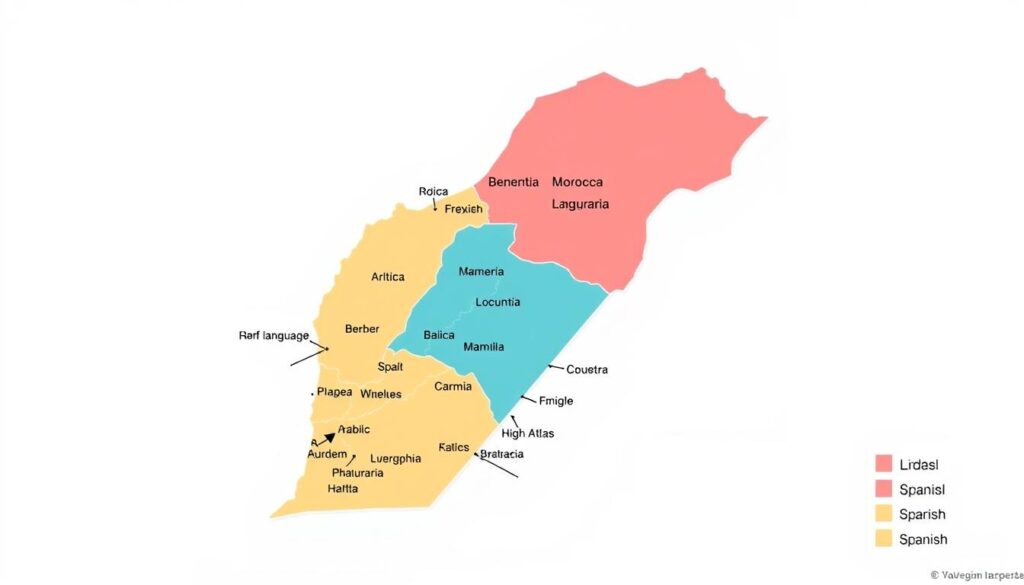This guide will take you through Morocco’s fascinating linguistic diversity, explaining the official languages, the widely-spoken Moroccan Arabic (Darija), the indigenous Berber languages, and the European influences that have shaped how Moroccans communicate today.
Morocco’s Linguistic Landscape: An Overview
Morocco stands out in North Africa for its remarkable linguistic diversity. Unlike many countries with a single dominant language, Morocco functions as a multilingual society where several languages coexist and serve different purposes in daily life.
The linguistic situation in Morocco can be categorized into three main groups:
- Native Languages: Moroccan Arabic (Darija) and Berber languages (Amazigh)
- Official/Standard Languages: Modern Standard Arabic and Standard Moroccan Berber
- Foreign Languages: French, Spanish, and increasingly, English
According to the 2024 Moroccan census, 92.7% of the population speaks Arabic (primarily Moroccan Arabic), while 24.8% speak Berber languages. This overlap indicates the widespread bilingualism in Moroccan society, with many citizens fluent in both language families.
Understand Morocco Before You Visit
Planning a trip to Morocco? Download our free guide to Moroccan language essentials and navigate the country with confidence.
The Official Languages of Morocco
Morocco’s constitution officially recognizes two languages: Modern Standard Arabic and Standard Moroccan Berber (Amazigh). This dual recognition reflects both Morocco’s Arab-Islamic heritage and its acknowledgment of the indigenous Berber population’s cultural rights.
Morocco’s constitution officially recognizes two languages: Modern Standard Arabic and Standard Moroccan Berber (Amazigh). This dual recognition reflects both Morocco’s Arab-Islamic heritage and its acknowledgment of the indigenous Berber population’s cultural rights.
Modern Standard Arabic (MSA) is the standardized, literary form of Arabic used throughout the Arab world. In Morocco, it serves as:
- The language of government communications and official documents
- The primary language of education in public schools
- The language of formal media, news broadcasts, and newspapers
- The language used for religious purposes, including sermons and Quranic studies
While MSA is widely understood by educated Moroccans, it’s important to note that it’s not typically used in everyday conversation. According to the 2024 census, 99.2% of Morocco’s literate population can read and write in Arabic, making it the foundation of the country’s educational system.
Standard Moroccan Berber (Amazigh)
In 2011, Morocco took the historic step of recognizing Amazigh (Berber) as an official language alongside Arabic. This recognition came after decades of Amazigh cultural activism and represents an important acknowledgment of Morocco’s indigenous heritage.
Standard Moroccan Berber is based on the three main Berber dialects spoken in Morocco:
Tashelhit
Spoken by approximately 14.2% of Moroccans, primarily in the Anti-Atlas Mountains and central Morocco.
Central Atlas Tamazight
Used by around 7.4% of the population, mainly in the Middle and High Atlas Mountains regions.
Tarifit
Spoken by roughly 3.2% of Moroccans, concentrated in the Rif Mountains of northern Morocco.
The standardization of Berber uses the Tifinagh alphabet, an ancient script revived for modern use. Since 2019, the Moroccan government has been working to expand Berber language education to all schools, though as of 2023, only about 10% of Moroccan pupils study Berber.
Moroccan Arabic (Darija): The Language of Daily Life

While Modern Standard Arabic is the official language, Moroccan Arabic—known locally as “Darija”—is the true mother tongue and everyday language for most Moroccans. Darija is spoken by 91.9% of Morocco’s population, with 80.6% considering it their native language.
What Makes Darija Unique?
Darija belongs to the Maghrebi Arabic dialect family but has several distinctive features that set it apart from other Arabic varieties:
Phonological Features
- Reduction of short vowels, creating consonant clusters
- Unique pronunciation of certain consonants
- Distinctive intonation patterns
Vocabulary Influences
- Substantial Berber substrate (vocabulary and grammar)
- French loanwords (especially for modern concepts)
- Spanish influence (particularly in northern regions)
- Some words from African Romance languages
Darija varies regionally across Morocco, with noticeable differences between urban and rural dialects. The dialect spoken in Casablanca, Rabat, Meknes, and Fez is considered the mainstream variety and dominates media and entertainment.
Written Darija
Traditionally, Darija has been primarily a spoken language, with Modern Standard Arabic used for writing. However, this is changing with the digital age. Today, Darija is increasingly written in:
- Social media posts and text messages (using Arabic script or Latin alphabet)
- Advertising and commercial signage
- Some newspapers and magazines
- Creative literature and song lyrics
When written in the Latin alphabet (especially in digital communication), Darija often uses numbers to represent sounds not found in European languages, such as 3 for the Arabic letter ع (ayn) and 7 for ح (ha).
Learn Essential Darija Phrases
Get our free Moroccan Arabic phrasebook with audio pronunciations to help you communicate with locals during your visit.
Berber Languages: Morocco’s Indigenous Linguistic Heritage
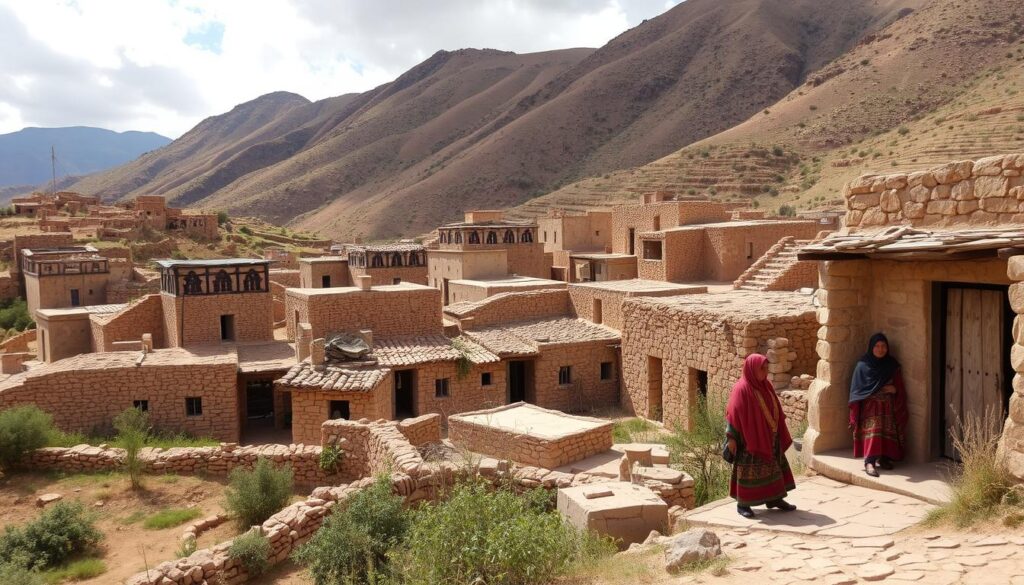
The Berber languages (Amazigh) represent Morocco’s indigenous linguistic heritage, predating the Arab conquest of North Africa. These languages are not merely dialects but distinct languages with their own grammatical structures, vocabularies, and cultural expressions.
Major Berber Languages in Morocco
| Language | Speakers (%) | Primary Regions | Notable Features |
| Tashelhit | 14.2% | Anti-Atlas Mountains, Souss Valley, High Atlas | Largest Berber language in Morocco; rich literary tradition |
| Central Atlas Tamazight | 7.4% | Middle Atlas, parts of High Atlas | Basis for standardized Amazigh; significant dialectal variation |
| Tarifit | 3.2% | Rif Mountains (northern Morocco) | Strong Spanish influence; distinctive phonology |
| Senhaja de Srair | Western Rif Mountains | Endangered; preserves ancient Berber features | |
| Ghomara | Western Rif Mountains | Critically endangered; only a few thousand speakers |
The Resurgence of Berber Identity
After decades of marginalization, Berber languages and culture have experienced a significant revival in Morocco. This resurgence is evident in several developments:
- Constitutional recognition as an official language in 2011
- Creation of the Royal Institute of Amazigh Culture (IRCAM) in 2001
- Standardization of the Tifinagh alphabet for writing Berber
- Introduction of Berber language education in schools
- Increased presence in media, including dedicated TV and radio channels
- Growing pride in Berber identity among younger generations
Today, more than 60% of Moroccans identify as Amazigh or Berber, acknowledging this aspect of their heritage even if they may not speak a Berber language fluently. This cultural identification transcends linguistic boundaries and represents an important part of Morocco’s national identity.
Explore Berber Culture and Language
Discover the rich heritage of Morocco’s indigenous Amazigh people with our interactive map and cultural guide.
European Languages in Morocco: Colonial Legacy and Modern Utility
French: The Language of Prestige and Opportunity
French maintains a prominent position in Morocco as a result of the French Protectorate (1912-1956). Despite not having official status, French serves as a de facto second language and is widely used in:
- Business and commerce
- Higher education (especially scientific and technical fields)
- Government administration
- Upscale urban settings and tourism
- Media and publishing
According to the 2024 census, 57.7% of Morocco’s literate population can read and write in French. The language is taught in schools from an early age, and in 2020, Morocco reintroduced French as the medium of instruction for science and mathematics after a period of Arabization.
French often serves as a marker of education and social status in Morocco. Code-switching between Darija and French is common in urban areas, particularly among the educated middle and upper classes.
Spanish: Regional Influence in the North
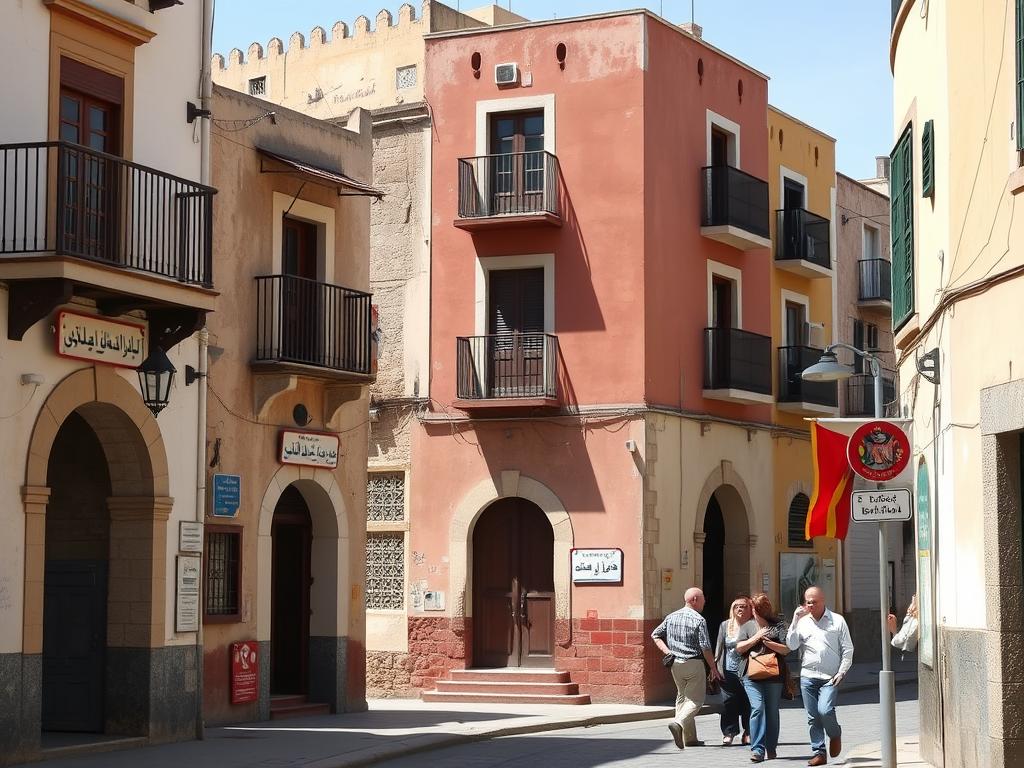
Spanish influence is concentrated in northern Morocco, particularly around cities like Tangier, Tetouan, and Larache. This influence stems from:
- The Spanish Protectorate in northern Morocco (1912-1956)
- Geographic proximity to Spain (visible from the northern coast)
- Ongoing economic and cultural ties with Spain
- Spanish television broadcasts received in northern regions
According to the 2024 census, only about 1.2% of Moroccans can read and write in Spanish, though spoken comprehension may be higher in the north. Spanish vocabulary has also influenced Moroccan Arabic, particularly in northern dialects.
English: The Rising Global Language
English is gaining significant ground in Morocco, especially among younger generations. The 2024 census reports that 20.5% of literate Moroccans can read and write in English, a notable increase from previous decades.
In July 2023, Morocco’s Ministry of Education announced plans to gradually introduce English instruction from secondary school, signaling the growing importance of the language. English is increasingly valued for:
- International business and tourism
- Access to global media and technology
- Higher education opportunities abroad
- Employment in multinational companies
Some youth movements have even called for English to replace French as Morocco’s primary foreign language, reflecting changing global dynamics and the perceived neutrality of English compared to the colonial associations of French.
Historical Evolution of Languages in Morocco
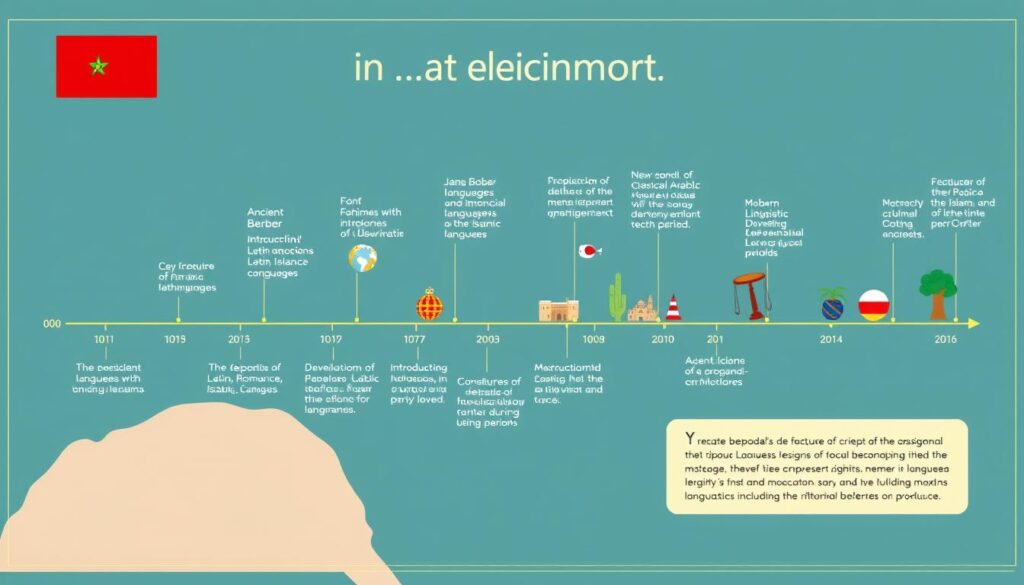
Morocco’s linguistic landscape has evolved through centuries of cultural contact, conquest, trade, and migration. Understanding this history helps explain the complex language situation in Morocco today.
Pre-Islamic Period: Berber and Ancient Languages
Before the Arab conquest, the linguistic landscape of Morocco included:
- Berber languages (indigenous to North Africa)
- Phoenician and Punic (brought by Carthaginian traders)
- Latin and African Romance (during Roman rule)
- Greek (used by some elites, including King Juba II of Mauretania)
The Berber languages dominated most of the territory, especially in rural and mountainous regions, while coastal cities often used Phoenician, Punic, or Latin for trade and administration.
Arab Conquest and Islamization (7th-12th centuries)
The Arab conquest of the Maghreb in the late 7th century introduced Arabic to Morocco. However, Arabization was a gradual process:
- Initially, Arabic was limited to urban centers and administrative functions
- The spread of Islam preceded the spread of the Arabic language
- Under the Almohad dynasty (12th century), sermons had to be delivered in both Arabic and Berber
- Rural areas remained predominantly Berber-speaking
Development of Moroccan Arabic (12th-19th centuries)
Moroccan Arabic (Darija) evolved gradually through:
- Contact between Arabic and Berber languages
- Influence from Andalusian Arabic (brought by refugees from Spain)
- Bedouin migrations, particularly the Banu Hilal tribes in the 11th century
- Trade contacts with Mediterranean cultures
The first recorded literary work in Moroccan Arabic was Al-Kafif az-Zarhuni’s epic zajal poem “al-Mala’ba” from the 14th century, during the Marinid dynasty.
Colonial Period and Modern Era (19th-20th centuries)
The colonial period introduced European languages and modern education systems:
- French Protectorate (1912-1956) in central Morocco established French as a language of administration and elite education
- Spanish Protectorate in northern Morocco and Western Sahara introduced Spanish influence
- Post-independence Arabization policies attempted to strengthen Arabic at the expense of French and Berber
- By 2000, Morocco shifted to a more multilingual approach, acknowledging the value of linguistic diversity
Contemporary Language Policy (21st century)
Morocco’s current language policy embraces multilingualism while affirming its Arab-Islamic and Amazigh identities:
- 2011 Constitution recognized Amazigh as an official language alongside Arabic
- 2019 legislation aimed to implement Amazigh education throughout the country
- Reintroduction of French as the language of instruction for scientific subjects
- Growing emphasis on English as a global language
- Increasing acceptance of Darija in media, advertising, and some forms of writing
Language in Daily Life: How Moroccans Navigate Multilingualism
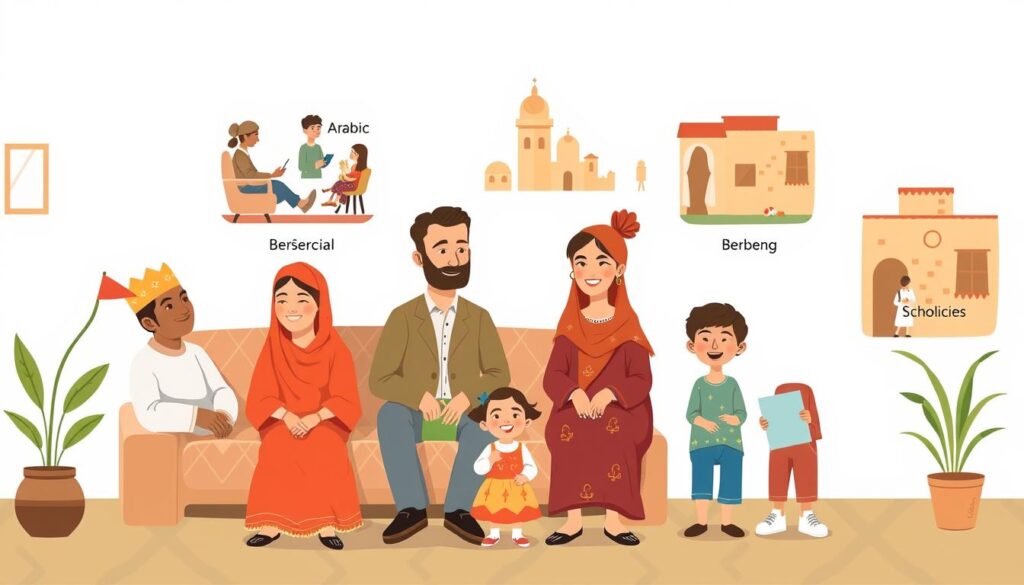
Morocco’s multilingualism isn’t just a matter of statistics—it’s lived daily by millions of Moroccans who navigate different languages in different contexts. This linguistic code-switching is a defining feature of Moroccan communication.
Domains of Language Use
| Domain | Primary Language(s) | Notes |
| Home/Family | Darija, Berber languages | The intimate languages of family life; often the only languages used by older generations |
| Street/Market | Darija, Berber in rural areas | The language of everyday transactions and social interactions |
| Education | MSA, French, some English | Arabic for humanities, French often for sciences and technical subjects |
| Government | MSA, French | Official documents often in both languages |
| Business/Professional | French, Darija, English | French dominates in formal business; English growing in international sectors |
| Media | MSA, Darija, French, Amazigh | News in MSA; entertainment often in Darija; dedicated channels for Amazigh |
| Religion | Classical Arabic | Quranic recitation and formal religious discourse |
Code-Switching and Language Mixing
A hallmark of Moroccan communication is the fluid mixing of languages within a single conversation or even a single sentence. This code-switching typically involves:
- Darija as the base language with French or Spanish terms inserted
- Technical or modern concepts expressed in French
- Numbers and dates often given in French
- Greetings and religious expressions in Standard Arabic
- Regional expressions in Berber languages
This mixing isn’t random but follows sociolinguistic patterns that signal education, social class, regional identity, and the relationship between speakers.
Digital Communication and Social Media
Digital platforms have created new spaces for language innovation in Morocco:
- Darija written in Latin script with numbers (3, 7, 9) representing Arabic sounds
- Multilingual posts that mirror spoken code-switching
- Greater freedom to use colloquial forms in writing
- New platforms for Amazigh language content
- Increased exposure to global English
These digital practices are influencing how younger Moroccans view language boundaries and may be accelerating linguistic change.
Frequently Asked Questions About Moroccan Languages
Is Moroccan a language?
“Moroccan” itself is not a language. When people refer to “Moroccan,” they’re usually talking about Moroccan Arabic (Darija), which is the most widely spoken language in Morocco. However, Morocco is home to multiple languages, including Berber languages, Standard Arabic, French, and Spanish. The linguistic situation in Morocco is characterized by multilingualism rather than a single “Moroccan language.”
What language do Moroccans speak most?
Moroccan Arabic (Darija) is the most widely spoken language in Morocco, with about 92% of the population speaking it. It serves as the primary everyday language for most Moroccans. However, many Moroccans are multilingual, with significant portions of the population also speaking Berber languages (24.8%), French (36-57% depending on the measure), and increasingly English (14-20%).
Is Moroccan Arabic different from Standard Arabic?
Yes, Moroccan Arabic (Darija) is significantly different from Modern Standard Arabic (MSA). The differences are so substantial that many linguists consider it a case of diglossia—two varieties of a language used for different functions. Darija has a simplified grammatical structure, different pronunciation, unique vocabulary (including Berber, French, and Spanish loanwords), and distinct expressions. Most Arabic speakers from the Middle East find Moroccan Arabic challenging to understand without exposure or study.
Do all Moroccans speak French?
No, not all Moroccans speak French, though it is widely used. According to the 2024 census, about 57.7% of literate Moroccans can read and write in French. French proficiency is higher in urban areas and among educated professionals, while it may be limited in rural regions and among older generations or those with less formal education. French serves as a second language for many Moroccans, particularly in professional, educational, and administrative contexts.
Are Berber languages dying out in Morocco?
While some smaller Berber languages like Senhaja de Srair and Ghomara are endangered, the major Berber languages (Tashelhit, Central Atlas Tamazight, and Tarifit) remain vital with millions of speakers. The constitutional recognition of Berber as an official language in 2011, increasing educational initiatives, and growing cultural pride have strengthened the position of Berber languages. However, urbanization and the dominance of Arabic and French in education and media do present ongoing challenges to intergenerational transmission in some communities.
What language should tourists learn for visiting Morocco?
For tourists, learning some basic Moroccan Arabic (Darija) phrases will be most appreciated by locals and useful in everyday situations. French is also widely understood in tourist areas, hotels, and restaurants, especially in cities and among those working in tourism. English proficiency is growing, particularly among younger Moroccans and in tourist zones. Learning a few greeting expressions in Berber would be appreciated in rural areas, especially in the Atlas Mountains or Berber villages.
Master Morocco’s Linguistic Landscape
Download our comprehensive guide to Moroccan languages, including pronunciation guides, cultural notes, and practical phrases for travelers.
Conclusion: Morocco’s Linguistic Mosaic
Morocco’s linguistic landscape is not simply a collection of separate languages but a dynamic ecosystem where languages interact, influence each other, and serve different functions in society. This multilingualism is both a product of Morocco’s rich history and a living expression of its identity at the crossroads of Africa, Europe, and the Middle East.
From the indigenous Berber languages to the Arabic dialects shaped by centuries of cultural exchange, from the colonial legacy of French to the growing influence of global English, Morocco’s languages tell the story of a nation that has always been a meeting point of civilizations.
For visitors and language enthusiasts alike, understanding Morocco’s linguistic diversity offers a deeper appreciation of its culture and people. Rather than asking “What is the Moroccan language?” perhaps the better question is “How do Moroccans use their many languages to express their complex and evolving identity?”
In this linguistic mosaic lies one of Morocco’s greatest cultural treasures—a reminder that diversity and adaptation have always been at the heart of Moroccan identity.

